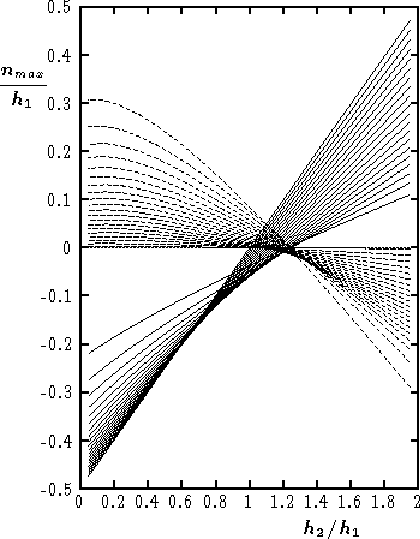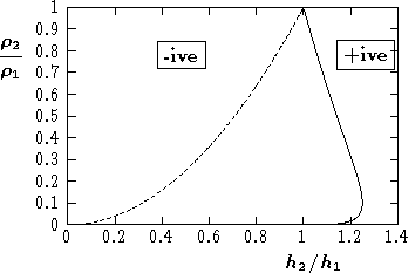 |
 |
The conjugate flow conditions given above can be solved numerically for free-surface boundary conditions as done by
Evans (1996). In this case, there does not appear to be nice analytic
forms1,
analagous to (6) and (7). It is imperative
therefore to represent the numerical solutions for the amplitudes graphically as shown in Figure 3, where the limiting surface and pycnocline amplitudes, n1 and n2, are
plotted for
![]() in steps of 0.05 over a
range of h2/h1 values between 0 and 2.
in steps of 0.05 over a
range of h2/h1 values between 0 and 2.
Note that at the larger oceanic ratios of
![]() the pycnocline limiting amplitudes,
the pycnocline limiting amplitudes,
![]() ,
are
largest and the free-surface limiting amplitudes,
,
are
largest and the free-surface limiting amplitudes,
![]() ,
are
smallest. In fact when
,
are
smallest. In fact when
![]() ,
,
![]() ,
and then asymptotes to the `rigid-lid' limiting amplitude.
Note also that free-surface and pycnocline amplitudes are always of opposite sign and thereby become zero simultaneously at
situations pertaining to congruent conjugate flows as described
by the free-surface locus in Fig. 4. Hence, negative
interfacial amplitude internal waves appear to have an associated free
top surface `bulge' whilst positive interfacial amplitudes
are accompanied by a free top surface `depression'.
,
and then asymptotes to the `rigid-lid' limiting amplitude.
Note also that free-surface and pycnocline amplitudes are always of opposite sign and thereby become zero simultaneously at
situations pertaining to congruent conjugate flows as described
by the free-surface locus in Fig. 4. Hence, negative
interfacial amplitude internal waves appear to have an associated free
top surface `bulge' whilst positive interfacial amplitudes
are accompanied by a free top surface `depression'.
Figure 4 shows the locus of the situations, characterised by
values of
![]() and h2/h1, at which the conjugate flows
become `congruent' (i.e.
and h2/h1, at which the conjugate flows
become `congruent' (i.e.
![]() ,
,
![]() and
and
![]() ), implying the limiting amplitudes, n1 and
n2, are zero. Of course this marks the boundary between positive and negative internal waves.
), implying the limiting amplitudes, n1 and
n2, are zero. Of course this marks the boundary between positive and negative internal waves.
 |
Remarkably, it is observed that the locus of congruent conjugate
flows for the ``free-surface'' case is confined entirely to the
range
![]() and appears to end as well as start at values of
h2/h1 = 1. Thus it appears that, with free surface boundary
conditions, no positive internal waves are possible at any density ratio
if
and appears to end as well as start at values of
h2/h1 = 1. Thus it appears that, with free surface boundary
conditions, no positive internal waves are possible at any density ratio
if
![]() .
The maximum value of h2/h1 on the locus is 1.25and occurs when
.
The maximum value of h2/h1 on the locus is 1.25and occurs when
![]() .
These numbers are certainly valid
to high numerical accuracy and, probably, can be shown to be exact.
.
These numbers are certainly valid
to high numerical accuracy and, probably, can be shown to be exact.
At this point, it is apposite to sound a note of caution. In the
limit when
![]() and
and
![]() ,
it might be
supposed that the motion of the bottom layer is unaffected by the
presence of the tenuous upper layer and should behave like a normal
``1-layer'' solitary wave. The conjugate flow limiting
amplitude in this situation would appear from (6) to be
,
it might be
supposed that the motion of the bottom layer is unaffected by the
presence of the tenuous upper layer and should behave like a normal
``1-layer'' solitary wave. The conjugate flow limiting
amplitude in this situation would appear from (6) to be
![]() i.e. as large as we care to make h2. Of
course, this conclusion does not accord with what we know of the maximum solitary wave that has a
i.e. as large as we care to make h2. Of
course, this conclusion does not accord with what we know of the maximum solitary wave that has a ![]() Stokes corner and a
limiting amplitude of
Stokes corner and a
limiting amplitude of
![]() (Evans and Ford 1996a; Williams 1981). Both
of these `extremal scenarios', though different, are ``exact'' insofar
as the relevant integral equations are exactly satisfied.
(Evans and Ford 1996a; Williams 1981). Both
of these `extremal scenarios', though different, are ``exact'' insofar
as the relevant integral equations are exactly satisfied.
This heralds the question of stability. In our opinion it is most
likely that the ``conjugate flow'' picture of an extremal form of
infinite width will prove unstable especially at the lower values of
![]() - indeed it is not clear that it is stable for any
density ratio. Though a formidable task, this underlines the need for a
stability analysis of all large amplitude internal wave solutions.
- indeed it is not clear that it is stable for any
density ratio. Though a formidable task, this underlines the need for a
stability analysis of all large amplitude internal wave solutions.
Acknowledgements:
The author is grateful for discussions on these topics with Prof. L. Vázquez, Dr. W.G. Easson, Dr. I-Fan Shen and Prof. G.L. Alfimov. This work was partially supported by a British Council ``Acciones Integradas'' award (ref: MDR/(1996/97)/1828) and the NATO grant (ref: OUTR.LG-960298).